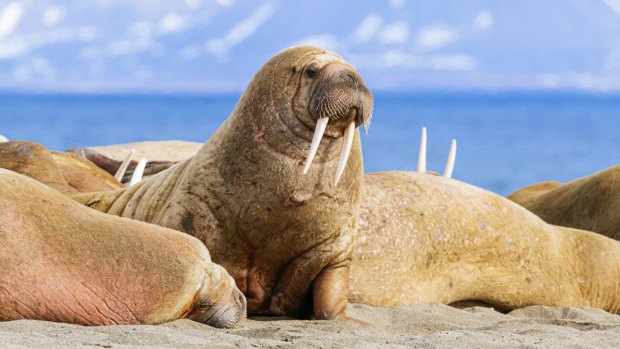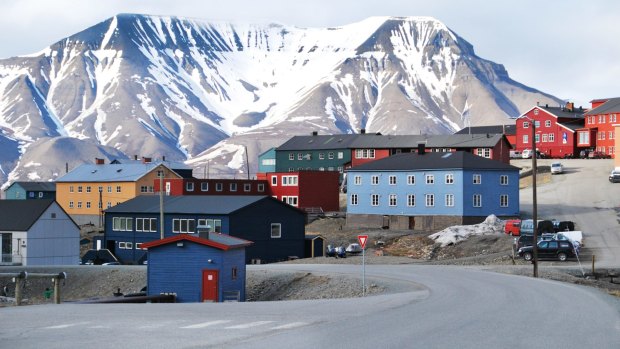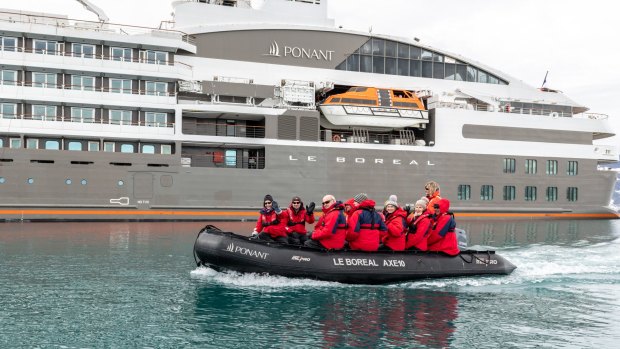This was published 4 years ago
Cruising Svalbard and Greenland: Ordinary people can now enjoy this astonishing place

Walruses hauled ashore on the Poolepynten peninsula on Prins Karls Forland island in the Svalbard archipelago. Credit: Andrew Peacock
There was a time when a journey to the Arctic involved packing fur coats, snow goggles, sleeping bags, sledges and a team of Siberian ponies. You might have been gone three years in appalling conditions, and returned minus a few fingers.
I count myself lucky to be flying above the Arctic Circle in a chartered aircraft as I tuck into croissants served by a French flight attendant. A journey this far north remains one of the ultimate adventures, but inaccessibility no longer comes with frostbite and a diet of seal blubber. A three-hour flight from Oslo wafts me in comfort to the Svalbard Islands, one of the world's remotest places. This is a hard-core destination, but a journey with Abercrombie & Kent considerably softens its edges.

The Svalbard Islands, one of the world's remotest places.Credit: iStock
What hasn't changed is the landscape and the thrilling sense you're at the limits of the earth. Svalbard appears in a clash of rock and ice through gaps torn in the clouds. We come in to land over bare hills gushing with muddy torrents. There are no trees. Longyearbyen airport is a grey shed hunkered on a gravelly shoreline. Wind whips across the tarmac. Baggage handlers layered in clothing seem fat as sumo wrestlers.
I can see all of Longyearbyen almost immediately. Like all frontier towns it has an atmosphere of impermanence and few architectural frills. Red and green houses straggle up the hillside like blocks of Lego, surrounded by scrap metal and shipping containers. The stubby wooden piles of the original settlement stick up through the permafrost like worn teeth. Abandoned coal-mining pylons look like alien landings.
Cloud hangs low above the hillsides, brooding and atmospheric. The tongues of glaciers glint white in the distance. The geography is completely exposed, concealed neither by forest nor field. I can see every gully and ravine, every pile of unstable rock, every hill rounded by long-departed glaciers. Improbably, white flowers grow. They have a 70-day window to put out a root or unfurl a petal before they hibernate for another 10 months. Arctic plants hover at the very extreme of life's requirements.

Abercrombie & Kent exclusively charters luxury ship Le Boreal for this cruise.Credit: Abercrombie & Kent
Not the humans though. Abercrombie & Kent's chartered ship Le Boreal floats in the bay and provides niceties that defy the rugged, hostile wilderness. We'll spend a week exploring Svalbard before sailing onwards to Greenland and Iceland and concluding in Reykjavik. This luxury cruise seems to scoff at the dramatic history of Arctic exploration with its tales of ice-crushed ships and ghastly mishaps. As we abandon any signs of civilisation and return from daily Zodiac excursions amid icebergs, the ship remains a capsule of designer chic, hot showers, Bordeaux wines and plates of grilled lobster tail.
This is a marvel of modern achievement. During the cruise, a team of expedition experts gives lectures in Arctic history that reveal what a mental and physical struggle this environment has always been for humans. The Arctic is about obsession and determination, the need to conquer and the desire to experience nature in all its hostile magnificence. I feel like a charlatan to be travelling with such ease, but incredibly fortunate. Never before have ordinary people been able to enjoy such an astonishing place.
The Arctic is a daily marvel. I awake to see Svalbard's mountains slumped under snow beyond my cabin window. Over the next days, we sail beneath 500-metre cliffs dense in nesting puffins and guillemots, and hillsides where reindeer nibble on Arctic moss. Mind-boggling glaciers slide down every valley. Fjortenda Julibreen Glacier is 16 kilometres wide and scatters a vast bay with chunks of ice. The wall of Lilliehook Glacier looms far above the ship in a spellbinding evening scene of greys and blues. Five glaciers meet at the head of Liefefjord, embraced in a ring of mountains.
By day five, we've passed 80 degrees and 31 minutes north and are approaching the edge of the Arctic icepack. The surface of the ocean is slick and dark as oil, with a fine cling-film skin of ice. Chunks of ice with vivid blue underwater tutus do a slow ballet of twirls as they're pushed away by the ship. Then the icepack appears, blue-edged and undulating. It heaves gently like the hide of a great sleeping animal. It continues for a thousand kilometres to the North Pole, and more again beyond, growing and shrinking with the seasons.
Our 1500-tonne steel ship hovers timidly at the edge of this seemingly fragile frozen world. I don't expect the noise. The icepack clanks and groans like a vast machine as it shifts and contorts and throws up pressure ridges. It melts and releases pockets of air, a champagne hiss multiplied to the roar of a waterfall. Tiny birds skim the icepack's surface, unintimidated by the frigid vastness.
Later we see polar bears at binocular distance, hunting for seals. Next day a polar bear spends a half-hour just 50 metres from the ship, an extraordinary encounter beyond my wildest hopes. Even the Arctic-experienced expedition leaders are buzzing with excitement.
You wouldn't want to be this close to a polar bear on land. On Zodiac excursions ashore the expedition team goes first, casting a perimeter manned by sentries with flares and guns. We see walruses up close at Sarstangen, though. They've hauled out onto a sandy point, where they occasionally roll over with a ripple of blubber and flash of toothy tusk. And the bird life is extraordinary: kittiwakes thick as snow, nesting guillemots so dense their guano makes our eyes water, a pair of rare ivory gulls.
The Abercrombie & Kent team comprises ornithologists and whale experts, botanists and geologists. There's always someone nearby, when ashore, to expound on their curious niche research into Arctic saxifrage, sedimentology or humpback migration. This human curiosity is reassuring. We're otherwise just a few blobs of red in our company-supplied polar jackets against a green-grey landscape of jagged hills, rearing cliffs and frigid ice.
Only a few people have been here before. On a shoreline in Prins Karls Forland we come across an abandoned trapper's hut. Rusting bolts and bullet casings litter the moss. Sometimes I find bleached reindeer antlers or storm-tossed logs, white as the bones of a dinosaur. But there's nothing in Alkefjellet. It seems like the loneliest place on Earth. Rock columns rise from a pounding ocean. Waterfalls spume off the icecap that sits heavy on the hilltops, pierced by jagged peaks. It's sullen but magnificent scenery. Hard-core and cold, happily tempered by soft beds and hot meals.
SHIP SHAPE
Abercrombie & Kent exclusively charters luxury ship Le Boreal for this cruise. It's a relatively small expedition vessel, more yacht than cruise ship, usually carrying 264 passengers but confined to 199 on A&K journeys. There's little razzmatazz. Indeed, the decor is rather minimalist, with cream-and-brown decor and eye-catching rather than flashy artworks that depict sailboats and maritime scenes.
The atmosphere and quality levels are akin to a boutique hotel. There are three lounges, a full-service spa, a theatre that hosts lectures on Arctic themes from expedition experts, and two dining venues. The main restaurant offers upmarket, French-influenced fine dining. The buffet venue is more relaxed but has the same excellent breads, pastries, cheese selections and complimentary wines. No need to give up your burgundy in this remote spot.
Le Boreal's nimble size allows it to sail indented bays and get close to the icepack, while its quiet engines don't seem to trouble whales or polar bears. Schedules are adapted to weather and wildlife. Daily excursions are made by Zodiac, with passengers efficiently boarded off the marina at the rear of the ship. An open-bridge policy means you can learn more about the challenges of Arctic sailing from the navigation team.
TRIP NOTES
CRUISE
Abercrombie & Kent runs expeditions to the Arctic between July and September. There are four in 2020, including one that sails the Northwest Passage. Brian Johnston travelled on a 15-day "In Search of the Polar Bear" cruise on Le Boreal, which next departs on July 31, 2020, visiting Svalbard before continuing on to Greenland and Iceland. Prices, from $21,720pp, include meals, drinks, gratuities, airport transfers, Arctic clothing and daily excursions with the expedition team. Phone 1300 590 317. See abercrombiekent.com.au
MORE
visitsvalbard.comtraveller.com.au/cruisestraveller.com.au/norway
Brian Johnston travelled as a guest of Abercrombie & Kent.
Sign up for the Traveller Deals newsletter
Get exclusive travel deals delivered straight to your inbox. Sign up now.